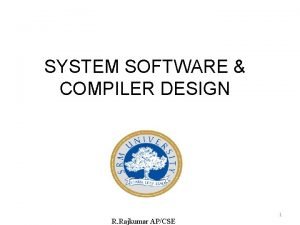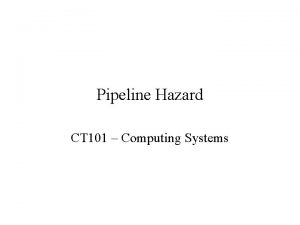Networking Systems Option Topic This option introduces the























- Slides: 23

Networking Systems Option Topic: This option introduces the nature of networking systems. File management, users and groups for any operating system are investigated. Students gain hands-on experience with setting up servers and protocols in a networked environment.

Outcomes A Student: 5. 2. 1 Describes and applies problem solving processes when creating solutions 5. 2. 2 Designs, produces and evaluates appropriate solutions to a range of challenging problems 5. 2. 3 Critically analyses decision-making processes in a range of information and software solutions

Student learn about: A communication network • Nature and role • Advantages and Disadvantages of a communication network such as: - Sharing of Peripheral devices - application programs - Data - Security of information - Access to databases Student learn to: • Describe the nature and role of a communication network • Discuss the Advantages and Disadvantages of establishing a network Resources used: Akande. P, I. D. (N. D). Networks: University of East London. Retrieved from University of East London Web site: http: //homepages. uel. ac. uk/u 0306091/Network. htm Morlet D, P. C. (2011). Understanding Computers. Boston : Cengage learning products. Oak, M. (2012, Febuary 24). Examples of Software: Buzzle. com. Retrieved from Buzzle. com Web site: http: //www. buzzle. com/articles/examples-of-software. html Oak, M. (N. D). Examples of Computer Hardware: Buzzle. com. Retrieved from Buzzle. com Web site: http: //www. buzzle. com/articles/examples-of-computerhardware. html Taylor D, e. C. (2012, March 9). Different Types of Communication Networks: e. How. Retrieved from e. How website: http: //www. ehow. com/list_7620661_different-types -communication-networks. html

Communication network What is communication network? A network which sends or shares information to a wide number of people. (Taylor D, 2012) So what is a network? A collection of computers or hardware devices which are connected together to share : hardware (such as a Bus e. g. Accelerated Graphic Port or a USB (Oak, Examples of Computer Hardware: Buzzle. com, N. D)), software (such as an operating system e. g. Microsoft office(Oak, 2012)) or data (such as dates and names or other information) (Morlet D, 2011) What does this simply mean? It means that information needs to be sent or shared to other people using computer network methods or hardware devices

Communication networks Can you name some? Advantages Disadvantages: Speed Resource sharing Email Shared drives Security for files or programs (Akande. P, N. D) � � � Multiple people on a network can slow down performance � System is open to hackers � Network faults can cause loss of data � Server fault can stop programs being available. (Akande. P, N. D)

Student learn about Types of Networks • Local area network (LAN) • Wide area network (WAN) • Virtual private network (VPN) Students learn to: • Design a small network of at least two workstations to allow for file sharing • Graphically represent a LAN or WAN using ICT such as graphics software • Explain the school communications link to outside world References used: • Blogspot. (2010, August 30). Computer Networking: Blogspot. Retrieved from Blogspot Web site: http: //dudleysenanayakacc. blogspot. com. au/search? updated-min=2010 -01 -01 T 00: 00 -08: 00&updated-max=2011 -01 -01 T 00: 00 -08: 00&maxresults=1 • Cybozu Share 360. (N. D). Remote Access: Cybozu Share 360. Retrieved from Cybozu Share 360 Web site. • Edraw. (2004 -2012). Local Area Network Technologies: Edraw. Retrieved from Edraw website. • Edraw. (2004 -2012). WAN Diagram Software: Edraw. Retrieved from Edraw: http: //www. edrawsoft. com/WAN-Diagrams. php • Morlet D, P. C. (2011). Understanding Computers. Boston : Cengage learning products.

Types of Networks communication takes place over varying networks these are listed below LAN WAN Local Area Network � Small area � Home, office or school (Morlet D, 2011) � � Image from (Edraw, 2004 -2012) Wide area networks � Covers a large geographical data � Consists of two or more LANs (Morlet D, 2011) Image from (Edraw, 2004 -2012)

Types of Networks MAN Metropolitan area networks Metropolitan area such as a city or town Operated by a city or town. Some can be created by Microsoft or Google � Less than 48. 3 km in size (Morlet D, 2011) � � � VPN Virtual private network Private secure path across a public network � Through a process called tunnelling which allows data to be sent securely via the internet (Morlet D, 2011) � � Image from (Blogspot, 2010) Image from (Cybozu Share 360, N. D)

Student learn about: Student learn to: Protocols • TCP/IP • IPX/SPX • Netbui • Appletalk • Define and describe the purpose of a protocol • Identify and describe types of protocols Reference List • D, L. (2011). Networking for Dummies. Indiana: Wiley Publishing Inc. • Webopedia. (2012). Net. BEUI: Webopedia. Retrieved from Webopedia web site: http: //www. webopedia. com/TERM/N/Netbeui. html

What is a Protocol? � Set of Rules that enables effective communication to occur � A protocol suite is created when protocols are matched (D, 2011)

“The Application layer provides the necessary services that support applications Some application protocols include File Transfer Protocol (FTP) Hypertext Transfer Protocol (HTTP)” (Tech-FAQ, N. D) “The Presentation layer is responsible for transforming information or data into format(s) the application layer can use. Some functions performed are: Data translation. Data encryption and decryption Data compression” (Tech-FAQ, N. D) “Functions performed at Session layer to establish, maintain and terminate communication sessions are: • Establishes, terminates, and monitors communication sessions between applications • Name lookup and security functions. • Data synchronization. • Controls whether the communication or messages being exchanged in a session are transmitted as full duplex messages or half duplex messages. ” (Tech-FAQ, N. D) Image and Quotes Referenced From: Tech-FAQ. (N. D). The OSI Model – What It Is; Why It Matters; Why It Doesn’t Matter. Retrieved from Tech-FAQ Web site: http: //www. tech-faq. com/osi-model. html “The Transport Layer is responsible for the delivery of messages between two or more networked hosts. It handles fragmentation and reassembly of messages and controls the reliability of a given link. Some protocols include: • Transmission Control Protocol (TCP) • User Datagram Protocol (UDP)” (Tech. FAQ, N. D) “The Network Layer is primarily responsible for establishing the paths used for transfer of data packets between devices on the network. ” (Tech -FAQ, N. D) “The Data-link layer of the OSI model enables the movement of data over a link from one device to another, by defining the interface between the network medium and the software on the computer. The Data-link layer maintains the data link between two computers to enable communications” (Tech-FAQ, N. D) “The Physical layer deals with establishing a physical connection between computers to enable communication. The physical layer is hardware specific and deals with the actual physical connection between the computer and the network medium. All devices that function at the Physical layer handle signalling”

TCP/IP Explanation. . Divide and win Puzzle Example This analogy is directly from the website http: //www. petervaldivia. com/technology/networks/tcp-ip. php � “If I have a 10000 piece puzzle and I want to send it to Tokyo, my TCP friend will pack it all up in several envelopes, so I will probably need about 325 stamps. Now my friend IP will carry all of them and will visit some transport agencies such as Australia post, express post, the post-office, etc. Every firm has its own routes so every envelope will take a different path from my house to Tokyo. My Japanese friend has another IP friend who will pick up all the envelopes, then give them to its Japanese friend TCP who will do the puzzle so my Japanese friend can see the puzzle. ” (Petervaldivia, 2008) So the TCP arranges the “puzzle” into smaller portions this is transmitted over the internet and received by the TCP server layer. The packets are then put into a file. The IP looks after the address’s of each packet. Each gateway computer checks the address to see where to forward the file (Petervaldivia, 2008).

Protocols Netbui � Pronounced net-booey. � Extended User Interface. � It is a transport layer protocol and is now considered obsolete. (Webopedia , 2012) � Netbeui was originally designed by IBM and Microsoft networks for their LAN Manager server (D, 2011) Apple. Talk � Used for apple computers � This suite includes a physical and data link layer called Local talk. (D, 2011) IPX/SPX � Was used for Net. Ware servers � Similar to TCP/IP therefore now only rarely used (D, 2011)

Learn to: Learn about: Data transmission modes • Simplex • Half duplex • Full duplex • Recognise different modes of transmission e. Tutorials. org. (2008 -2012). Data Transmission Modes: e. Tutorials. org. Retrieved from e. Tutorials. org: http: //etutorials. org/Networking/Lan+switching+firststep/Chapter+1. +Networking+Basics/Data+Transmission+Mo des/

Data transmission modes http: //etutorials. org/Networking/Lan+switching+first-step/Chapter+1. +Networking+Basics/Data+Transmission+Modes/ Simplex � � Data travels in a single direction Other examples is like a door bell Image From (e. Tutorials. org, 2008 -2012) Half Duplex � � Data travels in either direction but not at the same time Other examples is like a walkie talkie Image from (e. Tutorials. org, 2008 -2012) Full Duplex � � Data can travel in both directions at the same time Other example is like a telephone Image From (e. Tutorials. org, 20082012)

Student learn about Students learn to: Data transmission rates • Baud rates • Bits per second • Discuss and compare the methods used to measure transmission rates Reference List: • Difference Between. com. (2011, August 19). Difference Between Bit Rate and Baud Rate. Retrieved from Difference Between. com Web site: http: //www. differencebetween. com/difference-between-bit-rate-and-vs-baud-rate/ • Tech-FAQ. (n. d. ). The Difference between Bit Rate and Baud Rate. Retrieved from Tech-FAQ: http: //www. techfaq. com/difference-between-bit-rate-and-baud-rate. html

Data Transmission Rates Baud rates Vs Bits per second “A baud Rate is the number of times per second a signal in a communications channel changes. ” (Tech-FAQ) � “A Bit Rate is how many data bits are transmitted per second. ” (Tech-FAQ) � “A bit can represent only two levels, and a symbol can represent two or more levels. Therefore, bit rate is always greater than or equal to baud rate. ” (Difference Between. com, 2011) � “In most of the current technologies, bit rate is much higher than the baud rate. ” (Difference Between. com, 2011) � �

Student learn about Students learn to: Data transmission media • Wireless • Examine the range of media for data transmission Reference List: • Morlet D, P. C. (2011). Understanding Computers. Boston : Cengage learning products.

Data Transmission Media Wired networks are networks which are physically connected via caballing such as telephone, cable TV. Usually found in school, businesses and government agencies Wireless networks are networks which send data through the air to another device these are usually radio signals. Some examples include radio and mobile phones. Usually found in homes, universities and some businesses

Student learn about Students learn to: Client server and Peer-Peer networks • Compare a client/ server network with a peer-peer network. Reference List • Paul Parsons, e. C. (1999 -2012). What Is a Client Server Network? Retrieved from e. How Tech Web site: http: //www. ehow. com/about_5542179_client-servernetwork. html • D, L. (2011). Networking for Dummies. Indiana: Wiley Publishing Inc.

Client server Vs. Peer-Peer networks Peer-Peer Client Server May not have any servers but allows communications between workstations as if all workstations were equal (D, 2011) A client server network is defined as specific type of online network comprised of a single central computer acting as a server that directs multiple other computers, which are referred to as the clients. (Paul Parsons, 1999 -2012) Advantages Easy to set up and less time consuming No dedicated server computer needed Cost effective Easy to manage (D, 2011) � � Disadvantages: Smaller networks Security issues (have to share) Performance management Lack of standardisation (D, 2011) � � Advantages: � Can be updated by other computers and still maintaining only one control centre for the action. � makes it possible for companies to distribute information, upload data, or reach the program without being tied down to one individual computer site � Because the information is stored online, a client server model creates more power and control over what is being saved � increased security, often with encryption, ensuring that the data is only available to qualified individuals. (Paul Parsons, 1999 -2012) Disadvantages: system overload If too many different clients attempt to reach the shared network at the same time, there may be a failure or a slowing down of the connection � if the network is down, this disables access to the information from any site or client anywhere (Paul Parsons, 1999 -2012) � �

Activity � Who wants to be a computer geek Four groups each group choose a name Based on the presentation answer questions you have one min to discuss with your group the answer write the answer down and ansewers will be given at the end � The group with the most correct answers will be given a prize. � Rules: any groups found communicating with others will be deducted one point. � �

Reference List � � � � � Akande. P, I. D. (N. D). Networks: University of East London. Retrieved from University of East London Web site: http: //homepages. uel. ac. uk/u 0306091/Network. htm Blogspot. (2010, August 30). Computer Networking: Blogspot. Retrieved from Blogspot Web site: http: //dudleysenanayakacc. blogspot. com. au/search? updated-min=2010 -01 -01 T 00: 00 -08: 00&updated-max=2011 -01 -01 T 00: 0008: 00&max-results=1 Cybozu Share 360. (N. D). Remote Access: Cybozu Share 360. Retrieved from Cybozu Share 360 Web site. D, L. (2011). Networking for Dummies. Indiana: Wiley Publishing Inc. Difference Between. com. (2011, August 19). Difference Between Bit Rate and Baud Rate. Retrieved from Difference Between. com Web site: http: //www. differencebetween. com/difference-between-bit-rate-and-vs-baud-rate/ Edraw. (2004 -2012). Local Area Network Technologies: Edraw. Retrieved from Edraw website. Edraw. (2004 -2012). WAN Diagram Software: Edraw. Retrieved from Edraw: http: //www. edrawsoft. com/WAN-Diagrams. php e. Tutorials. org. (2008 -2012). Data Transmission Modes: e. Tutorials. org. Retrieved from e. Tutorials. org: http: //etutorials. org/Networking/Lan+switching+first-step/Chapter+1. +Networking+Basics/Data+Transmission+Modes/ Morlet D, P. C. (2011). Understanding Computers. Boston : Cengage learning products. Oak, M. (2012, Febuary 24). Examples of Software: Buzzle. com. Retrieved from Buzzle. com Web site: http: //www. buzzle. com/articles/examples-of-software. html Oak, M. (N. D). Examples of Computer Hardware: Buzzle. com. Retrieved from Buzzle. com Web site: http: //www. buzzle. com/articles/examples-of-computer-hardware. html Paul Parsons, e. C. (1999 -2012). What Is a Client Server Network? Retrieved from e. How Tech Web site: http: //www. ehow. com/about_5542179_client-server-network. html Petervaldivia. (2008). TCP/IP Protocol. Retrieved from Petervaldivia Web site: http: //www. petervaldivia. com/technology/networks/tcpip. php Taylor D, e. C. (2012, March 9). Different Types of Communication Networks: e. How. Retrieved from e. How website: http: //www. ehow. com/list_7620661_different-types-communication-networks. html Tech-FAQ. (N. D). The OSI Model – What It Is; Why It Matters; Why It Doesn’t Matter. Retrieved from Tech-FAQ Web site: http: //www. tech-faq. com/osi-model. html Tech-FAQ. (n. d. ). The Difference between Bit Rate and Baud Rate. Retrieved from Tech-FAQ: http: //www. tech-faq. com/differencebetween-bit-rate-and-baud-rate. html Webopedia. (2012). Net. BEUI: Webopedia. Retrieved from Webopedia web site: http: //www. webopedia. com/TERM/N/Netbeui. html Wilson, C. (2007). Exploring IST: Option 6 – Networking Systems. Retrieved from Exploring Information and Software Technology Fourth Edition : http: //www. cambridge. edu. au/education/companion/exploring/files/EIST_TP_Op 06. pdf
 Sdn vs traditional networking
Sdn vs traditional networking Bssd adalah
Bssd adalah Stock options terminology
Stock options terminology What is the climax of the story the lion and the mouse
What is the climax of the story the lion and the mouse Elements of exposition
Elements of exposition Cat morgan
Cat morgan The designer express the ideas in terms related to the
The designer express the ideas in terms related to the Stalls
Stalls Jeep/eagle introduces a new product
Jeep/eagle introduces a new product Examples of clinchers
Examples of clinchers Narrow down the topic
Narrow down the topic Module 10 topic 3 drivers ed
Module 10 topic 3 drivers ed Free enterprise system def
Free enterprise system def Hát kết hợp bộ gõ cơ thể
Hát kết hợp bộ gõ cơ thể Slidetodoc
Slidetodoc Bổ thể
Bổ thể Tỉ lệ cơ thể trẻ em
Tỉ lệ cơ thể trẻ em Voi kéo gỗ như thế nào
Voi kéo gỗ như thế nào Chụp tư thế worms-breton
Chụp tư thế worms-breton Chúa yêu trần thế
Chúa yêu trần thế Môn thể thao bắt đầu bằng từ đua
Môn thể thao bắt đầu bằng từ đua Thế nào là hệ số cao nhất
Thế nào là hệ số cao nhất Các châu lục và đại dương trên thế giới
Các châu lục và đại dương trên thế giới Công thức tính độ biến thiên đông lượng
Công thức tính độ biến thiên đông lượng













































